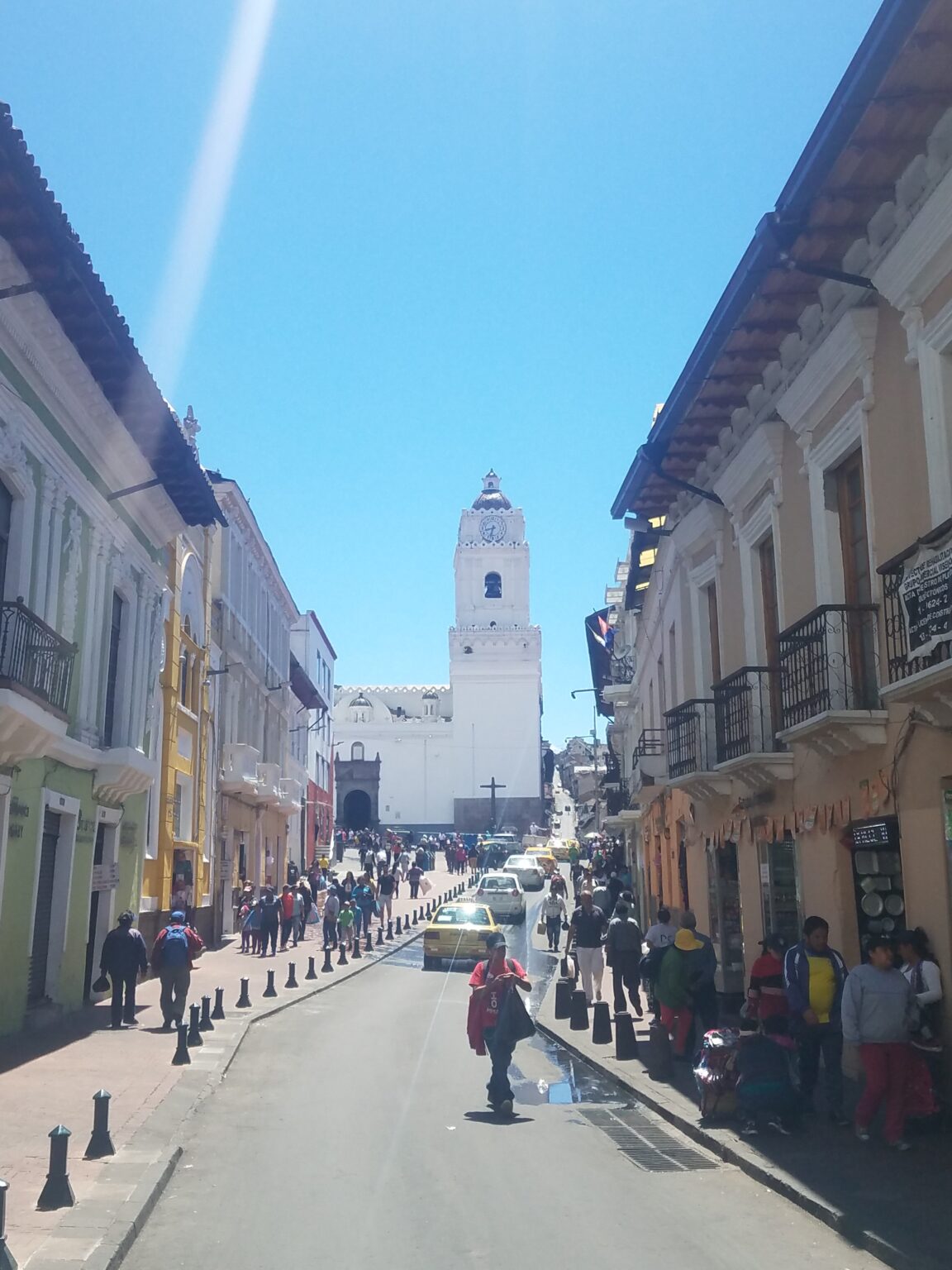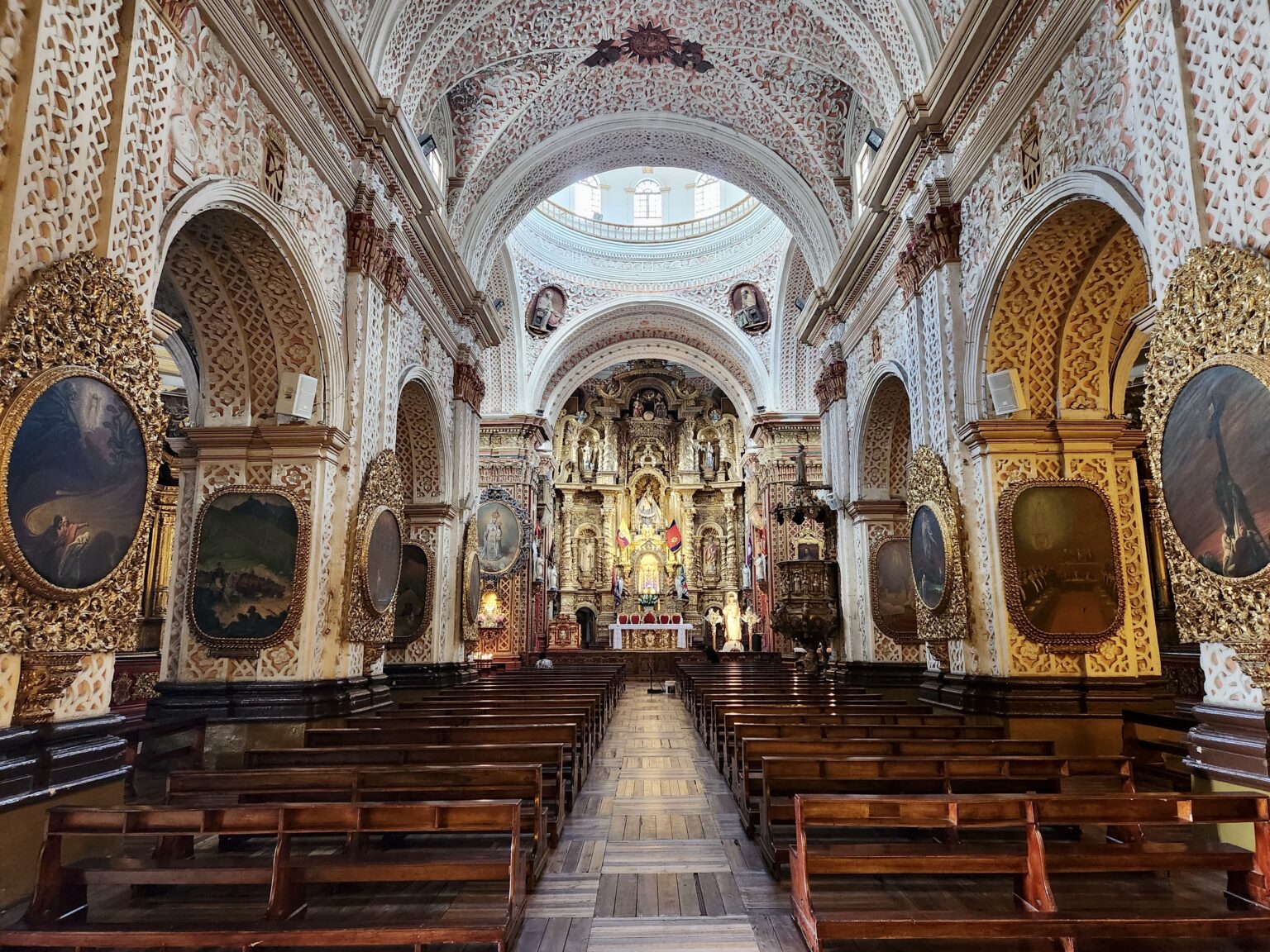Español
La Catedral Metropolitana de Quito, ubicada en el Centro Histórico frente a la Plaza de la Independencia, es la sede de la Arquidiócesis Primada y desde 1995 es considerada la Catedral Primada del Ecuador, máxima jerarquía de la Iglesia católica en el país. Su importancia histórica y religiosa, junto con su singular ubicación y arquitectura, la convierten en uno de los templos más emblemáticos de la ciudad y patrimonio de gran valor cultural.
Historia inicial.
Tras la fundación de Quito en 1534, se destinó el flanco sur de la Plaza Mayor para levantar la iglesia matriz. El primer templo fue construido entre 1562 y 1565 en adobe y paja, pero pronto se sustituyó por una obra en cal y canto inaugurada en 1572. A lo largo de los siglos sufrió reparaciones por terremotos, que permitieron ampliaciones como nuevas naves, sacristía y sala capitular, enriquecidas con retablos y artesonados.
Arquitectura exterior.
La catedral actual es fruto de reconstrucciones tras los sismos de los siglos XVIII y XIX. Destaca la incorporación del neoclasicismo con el atrio, la escalinata semicircular y el templete catedralicio. Su disposición lateral respecto a la plaza responde a la topografía irregular. La torre campanario fue destruida en 1868 y reconstruida en 1930 con estilo prusiano, mientras que elementos como el “Gallo de la Catedral” y placas conmemorativas refuerzan su simbolismo histórico.
Arquitectura interior.
El templo tiene planta longitudinal de tres naves, con cubiertas de arcos apuntados y artesonado mudéjar en cedro. Alberga capillas laterales con retablos barrocos y mausoleos, además de un retablo mayor con obras de la Escuela Quiteña, como las esculturas de Caspicara y lienzos de Manuel Samaniego.
Esculturas.
La Catedral conserva valiosas esculturas en cada retablo y capilla, además de mausoleos y cenotafios de personajes religiosos, políticos y de la independencia ecuatoriana. Estas piezas, elaboradas en distintas épocas, son una muestra del talento de la Escuela Quiteña.


English
The Metropolitan Cathedral of Quito, located in the Historic Center across from Independence Square, is the seat of the Primate Archdiocese and since 1995 has been considered the Primate Cathedral of Ecuador, the highest authority of the Catholic Church in the country. Its historical and religious significance, along with its unique location and architecture, make it one of the city’s most emblematic churches and a site of great cultural value.
Early History.
After the founding of Quito in 1534, the southern side of the Plaza Mayor was designated for the construction of the main church. The first church was built between 1562 and 1565 in adobe and straw, but it was soon replaced by a stone and mortar structure inaugurated in 1572. Over the centuries, it suffered repairs due to earthquakes, which allowed for expansions such as new naves, a sacristy, and a chapter house, enriched with altarpieces and coffered ceilings.
Exterior Architecture.
The current cathedral is the result of reconstructions following the earthquakes of the 18th and 19th centuries. Its Neoclassical influence is notable, with the atrium, the semicircular staircase, and the cathedral temple. Its lateral position relative to the plaza reflects the irregular topography. The bell tower was destroyed in 1868 and rebuilt in 1930 in the Prussian style, while elements such as the «Cathedral Rooster» and commemorative plaques reinforce its historical symbolism.
Interior Architecture.
The church has a longitudinal floor plan with three naves, with pointed arches and Mudejar cedar coffered ceilings. It houses side chapels with Baroque altarpieces and mausoleums, as well as a main altarpiece with works from the Quito School, such as sculptures by Caspicara and canvases by Manuel Samaniego.
Sculptures.
The Cathedral preserves valuable sculptures in every altarpiece and chapel, as well as mausoleums and cenotaphs of religious, political, and Ecuadorian independence figures. These pieces, crafted in different eras, are a testament to the talent of the Quito School.